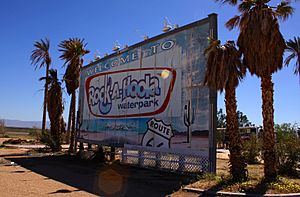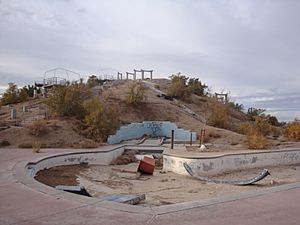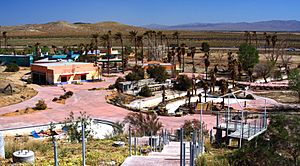Lake Dolores Waterpark facts for kids
Quick facts for kids Lake Dolores Waterpark |
|
|---|---|

The Rock-a-Hoola sign that greeted visitors into the park, April 2011.
|
|
| Location | Newberry Springs, California, United States |
| Coordinates | 34°56′54″N 116°41′15″W / 34.948234°N 116.687481°W |
| Opened | May 1962 |
| Closed | Summer 2004 |
| Previous names |
|
| Status | Closed |
Lake Dolores Waterpark is an old, abandoned waterpark. It is located in the Mojave Desert in Newberry Springs, California, near Interstate 15. Over the years, this waterpark had different names. These included Lake Dolores, Rock–A–Hoola Waterpark, and Discovery Waterpark.
Contents
The Early Years: 1950s to 1980s
The waterpark was first built by a local businessman named Bob Byers. He made it for his own family to enjoy. He named the main lake, Lake Dolores, after his wife.
Building the Park
Work on the park started in the late 1950s and early 1960s. Bob Byers chose a dry, desert area for the park. This spot was special because it had underground springs. These springs fed the lake, which was a large, man-made body of water.
In May 1962, a simple campground opened to the public. It was next to the small lake. People traveling between Los Angeles and Las Vegas often stopped there. Motocross fans also used the campground.
Over the next 25 years, more rides were added. The campground slowly became a full waterpark. It was even advertised on TV with a fun slogan: "The Fun Spot of The Desert!"
Exciting Rides and Attractions
The park had many cool attractions for visitors.
- Waterslides: There were eight tall, steel waterslides. They were about 150 feet (46 meters) long. Riders would go down on small plastic "floaties." They would skim across the water at the bottom.
- Standing Slides: Two V-shaped waterslides were also about 150 feet (46 meters) long. Riders stood up on these. They would shoot out into the air like a human cannonball before landing in the water.
- Zip-Cord: This ride let people hang from a hand-held device. They would zip along a wire for about 200 feet (61 meters). At the end, they would swing forward into the lagoon.
- Diving and Swings: A smaller lake had three high diving boards. There were also three trapeze-like swings. Riders could launch themselves from these swings into the lake.
- Raft Rides: The "Big Bopper" was a fast group raft ride. The "Lazy River" was a slower, more relaxing ride.
- Other Fun: The park also had bumper boats, a Jet Ski racetrack, and a swimming pool.
The park was most popular from the early 1970s to the mid-1980s. But in the late 1980s, fewer people visited. Eventually, the park closed down.
New Beginnings: 1990 to 2004
Rock–A–Hoola Waterpark
In 1990, Bob Byers sold the closed park. A group of investors bought it. They wanted to create a new park with a 1950s theme.
In 1995, the old waterslides were removed. New, modern fiberglass slides were put in their place. These new slides were painted red, white, and blue. The park reopened on July 4, 1998, with a new name: "Rock–A–Hoola Waterpark." This new park played 1950s and 1960s rock and roll music. It also had a river ride where people floated on tubes.
In 1999, a large music event called Electric Daisy Carnival was held at the park.
However, the park soon faced financial problems. It closed down again in 2000. The property was eventually returned to Dolores Byers, Bob Byers' wife. She then sold the park in 2001.
Discovery Waterpark
After some renovations, the waterpark opened again in May 2002. It had another new name: Discovery Waterpark. It was open on weekends in 2002 and 2003. In the summer of 2004, the park was open only sometimes. Since then, the park has been closed.
What Happened After the Park Closed?
Over the years, many ideas came up to reopen the park. In 2003, former athlete Ron Brown wanted to buy the park. He hoped to turn it into a camp for young people who needed help. But this plan did not work out.
In 2009, some of the park's rides were sold. The "Big Bopper" and "Thunder Road" waterslides were moved to a waterpark in Canada. The abandoned park was often damaged by people. Many buildings were torn apart for metal. People who explore abandoned places often visited the park, even though there were "no trespassing" signs.
The park has also appeared in TV shows and films:
- In March 2008, the park was shown on the reality show Rob & Big on MTV. Skateboarder Rob Dyrdek and his friends used the slides for skateboard stunts.
- In June 2012, a skate film called Kilian Martin: Altered Route featured the park.
- In 2013, a group of artists called TrustoCorp painted many signs and buildings in the park. They turned it into an art project.
- In 2014, the park was used for a challenge on Top Gear America.
- In October 2016, the park was featured on the TV show Abandoned on Viceland.
In October 2018, a fire damaged many of the remaining buildings. After this, security guards were hired to protect the property.



